Abstract
This study has evaluated the effect of breathing 100% oxygen, carbogen and carbon monoxide (at 660 p.p.m.) on the bioenergetic and oxygenation status and the radiation response of 200-mm3 C3H mammary carcinomas grown in the feet of CDF mice. Bioenergetic status was assessed by 31P magnetic resonance spectroscopy (MRS) using a 7-tesla spectrometer with both short (2 s) and long (6 s) pulse repetition times. Tumour partial pressure of oxygen (PO2) was measured with an Eppendorf polarographic electrode; the oxygenation parameters were the median pO2 and fraction of pO2 values < or = 2.5 mmHg. The radiation response was estimated using a tumour growth delay assay (time to grow three times treatment volume). Carbon monoxide breathing decreased tumour pO2 and compromised the radiation response, but the beta-nucleoside triphosphate (NTP)/Pi ratio was unchanged. Both carbogen and oxygen (100%) increased tumour pO2 and beta-NTP/Pi and enhanced the radiation response, the effects being similar under the two gassing conditions and dependent on the gas breathing time. Thus, in this tumour model, 31P-MRS can detect hyperoxic changes, but because cells can remain metabolically active even at low oxygen tensions the beta-NTP/Pi did not correlate with low tissue oxygenation. An analysis of variance showed that gas breathing time induced a significant systematic effect on beta-NTP/Pi, the MRS pulse repetition time had a significant effect on beta-NTP/Pi change under hypoxic but not under hyperoxic conditions and the type of gas that was inhaled had a significant effect on beta-NTP/Pi.
Full text
PDF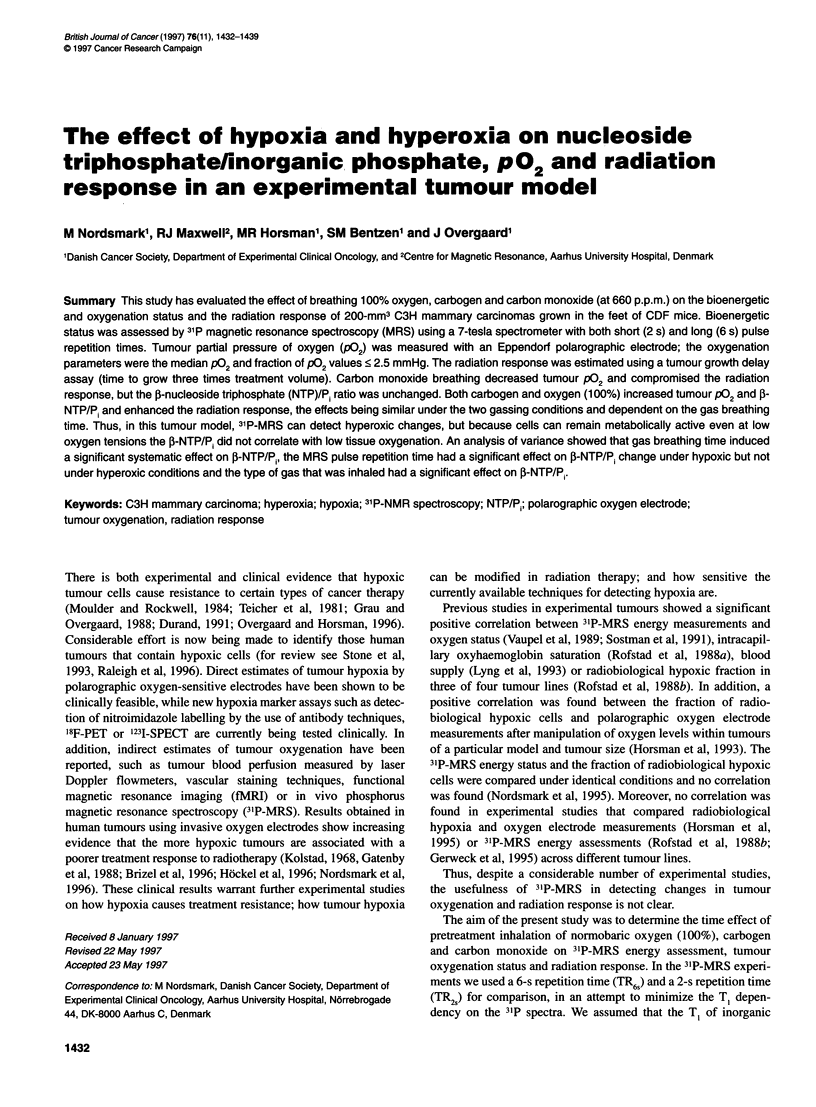
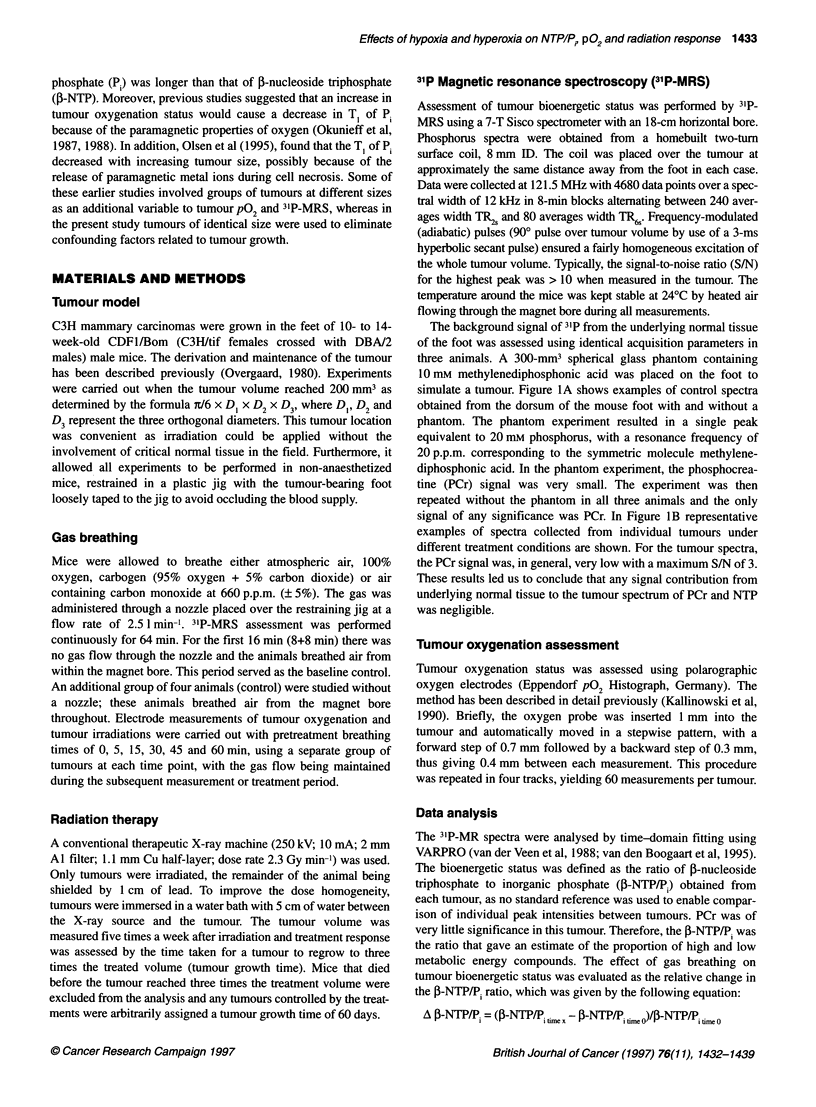



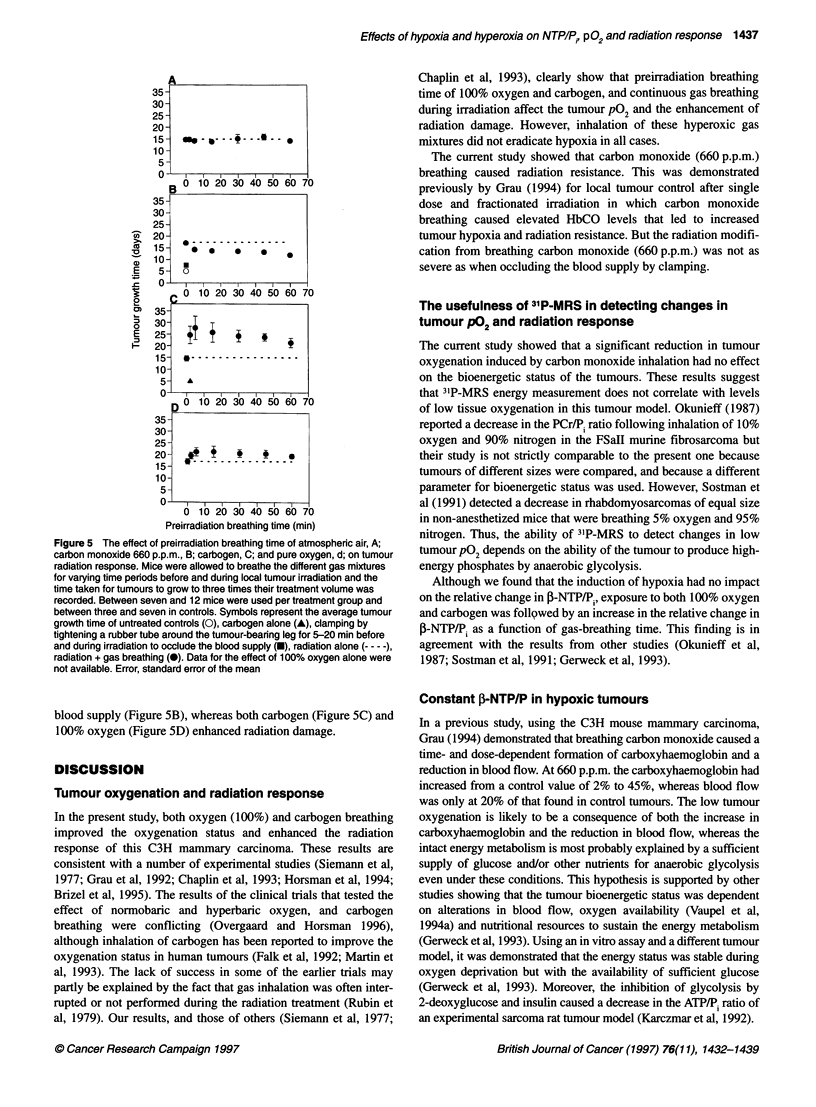
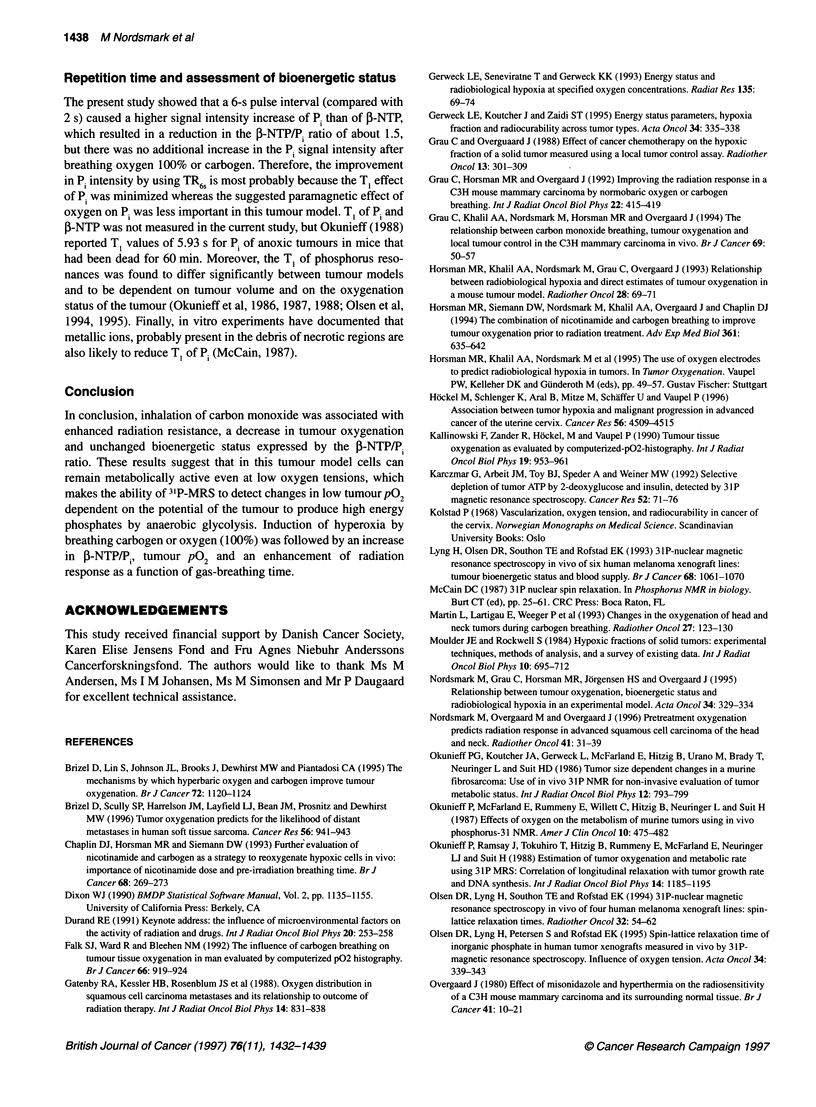
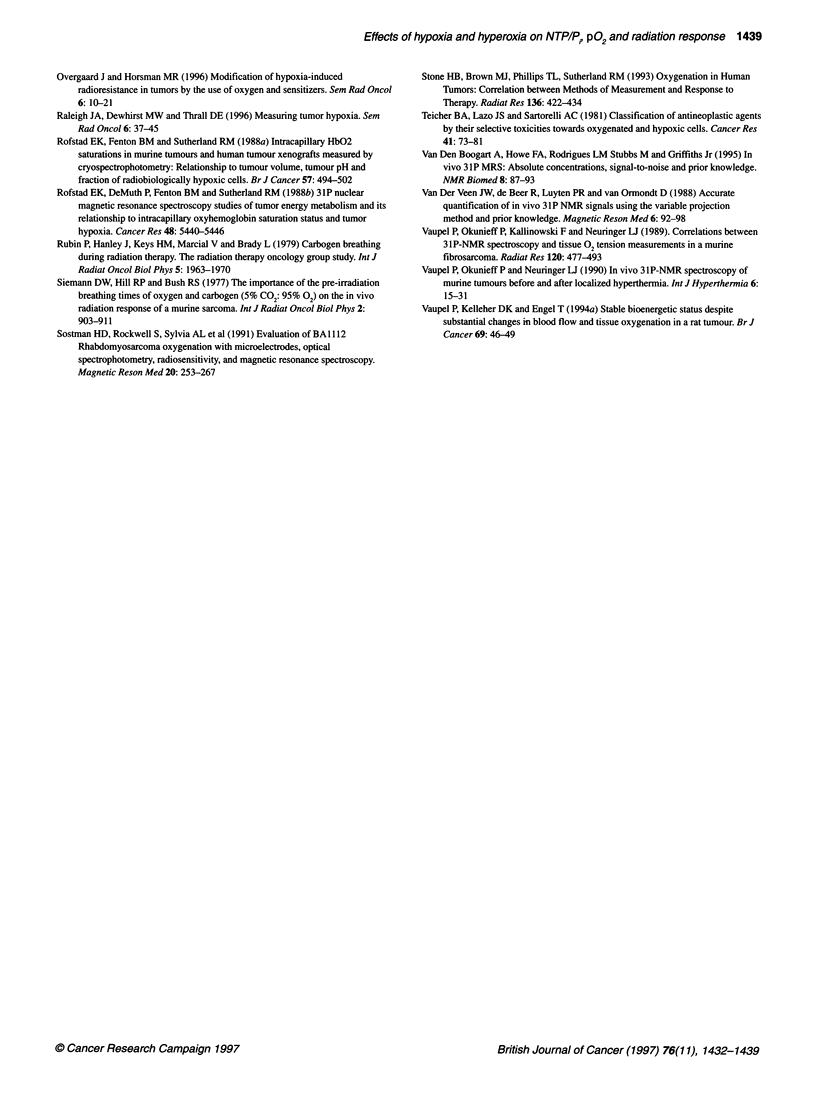
Images in this article
Selected References
These references are in PubMed. This may not be the complete list of references from this article.
- Brizel D. M., Lin S., Johnson J. L., Brooks J., Dewhirst M. W., Piantadosi C. A. The mechanisms by which hyperbaric oxygen and carbogen improve tumour oxygenation. Br J Cancer. 1995 Nov;72(5):1120–1124. doi: 10.1038/bjc.1995.474. [DOI] [PMC free article] [PubMed] [Google Scholar]
- Brizel D. M., Scully S. P., Harrelson J. M., Layfield L. J., Bean J. M., Prosnitz L. R., Dewhirst M. W. Tumor oxygenation predicts for the likelihood of distant metastases in human soft tissue sarcoma. Cancer Res. 1996 Mar 1;56(5):941–943. [PubMed] [Google Scholar]
- Chaplin D. J., Horsman M. R., Siemann D. W. Further evaluation of nicotinamide and carbogen as a strategy to reoxygenate hypoxic cells in vivo: importance of nicotinamide dose and pre-irradiation breathing time. Br J Cancer. 1993 Aug;68(2):269–273. doi: 10.1038/bjc.1993.326. [DOI] [PMC free article] [PubMed] [Google Scholar]
- Durand R. E. Keynote address: the influence of microenvironmental factors on the activity of radiation and drugs. Int J Radiat Oncol Biol Phys. 1991 Feb;20(2):253–258. doi: 10.1016/0360-3016(91)90100-i. [DOI] [PubMed] [Google Scholar]
- Falk S. J., Ward R., Bleehen N. M. The influence of carbogen breathing on tumour tissue oxygenation in man evaluated by computerised p02 histography. Br J Cancer. 1992 Nov;66(5):919–924. doi: 10.1038/bjc.1992.386. [DOI] [PMC free article] [PubMed] [Google Scholar]
- Gatenby R. A., Kessler H. B., Rosenblum J. S., Coia L. R., Moldofsky P. J., Hartz W. H., Broder G. J. Oxygen distribution in squamous cell carcinoma metastases and its relationship to outcome of radiation therapy. Int J Radiat Oncol Biol Phys. 1988 May;14(5):831–838. doi: 10.1016/0360-3016(88)90002-8. [DOI] [PubMed] [Google Scholar]
- Gerweck L. E., Koutcher J., Zaidi S. T. Energy status parameters, hypoxia fraction and radiocurability across tumor types. Acta Oncol. 1995;34(3):335–338. doi: 10.3109/02841869509093985. [DOI] [PubMed] [Google Scholar]
- Gerweck L. E., Seneviratne T., Gerweck K. K. Energy status and radiobiological hypoxia at specified oxygen concentrations. Radiat Res. 1993 Jul;135(1):69–74. [PubMed] [Google Scholar]
- Grau C., Horsman M. R., Overgaard J. Improving the radiation response in a C3H mouse mammary carcinoma by normobaric oxygen or carbogen breathing. Int J Radiat Oncol Biol Phys. 1992;22(3):415–419. doi: 10.1016/0360-3016(92)90844-8. [DOI] [PubMed] [Google Scholar]
- Grau C., Khalil A. A., Nordsmark M., Horsman M. R., Overgaard J. The relationship between carbon monoxide breathing, tumour oxygenation and local tumour control in the C3H mammary carcinoma in vivo. Br J Cancer. 1994 Jan;69(1):50–57. doi: 10.1038/bjc.1994.8. [DOI] [PMC free article] [PubMed] [Google Scholar]
- Grau C., Overgaard J. Effect of cancer chemotherapy on the hypoxic fraction of a solid tumor measured using a local tumor control assay. Radiother Oncol. 1988 Dec;13(4):301–309. doi: 10.1016/0167-8140(88)90225-3. [DOI] [PubMed] [Google Scholar]
- Hockel M., Schlenger K., Aral B., Mitze M., Schaffer U., Vaupel P. Association between tumor hypoxia and malignant progression in advanced cancer of the uterine cervix. Cancer Res. 1996 Oct 1;56(19):4509–4515. [PubMed] [Google Scholar]
- Horsman M. R., Khalil A. A., Nordsmark M., Grau C., Overgaard J. Relationship between radiobiological hypoxia and direct estimates of tumour oxygenation in a mouse tumour model. Radiother Oncol. 1993 Jul;28(1):69–71. doi: 10.1016/0167-8140(93)90188-e. [DOI] [PubMed] [Google Scholar]
- Horsman M. R., Siemann D. W., Nordsmark M., Khalil A. A., Overgaard J., Chaplin D. J. The combination of nicotinamide and carbogen breathing to improve tumour oxygenation prior to radiation treatment. Adv Exp Med Biol. 1994;361:635–642. doi: 10.1007/978-1-4615-1875-4_116. [DOI] [PubMed] [Google Scholar]
- Kallinowski F., Zander R., Hoeckel M., Vaupel P. Tumor tissue oxygenation as evaluated by computerized-pO2-histography. Int J Radiat Oncol Biol Phys. 1990 Oct;19(4):953–961. doi: 10.1016/0360-3016(90)90018-f. [DOI] [PubMed] [Google Scholar]
- Karczmar G. S., Arbeit J. M., Toy B. J., Speder A., Weiner M. W. Selective depletion of tumor ATP by 2-deoxyglucose and insulin, detected by 31P magnetic resonance spectroscopy. Cancer Res. 1992 Jan 1;52(1):71–76. [PubMed] [Google Scholar]
- Lyng H., Olsen D. R., Southon T. E., Rofstad E. K. 31P-nuclear magnetic resonance spectroscopy in vivo of six human melanoma xenograft lines: tumour bioenergetic status and blood supply. Br J Cancer. 1993 Dec;68(6):1061–1070. doi: 10.1038/bjc.1993.483. [DOI] [PMC free article] [PubMed] [Google Scholar]
- Martin L., Lartigau E., Weeger P., Lambin P., Le Ridant A. M., Lusinchi A., Wibault P., Eschwege F., Luboinski B., Guichard M. Changes in the oxygenation of head and neck tumors during carbogen breathing. Radiother Oncol. 1993 May;27(2):123–130. doi: 10.1016/0167-8140(93)90132-r. [DOI] [PubMed] [Google Scholar]
- Moulder J. E., Rockwell S. Hypoxic fractions of solid tumors: experimental techniques, methods of analysis, and a survey of existing data. Int J Radiat Oncol Biol Phys. 1984 May;10(5):695–712. doi: 10.1016/0360-3016(84)90301-8. [DOI] [PubMed] [Google Scholar]
- Nordsmark M., Grau C., Horsman M. R., Jörgensen H. S., Overgaard J. Relationship between tumour oxygenation, bioenergetic status and radiobiological hypoxia in an experimental model. Acta Oncol. 1995;34(3):329–334. doi: 10.3109/02841869509093984. [DOI] [PubMed] [Google Scholar]
- Nordsmark M., Overgaard M., Overgaard J. Pretreatment oxygenation predicts radiation response in advanced squamous cell carcinoma of the head and neck. Radiother Oncol. 1996 Oct;41(1):31–39. doi: 10.1016/s0167-8140(96)91811-3. [DOI] [PubMed] [Google Scholar]
- Okunieff P. G., Koutcher J. A., Gerweck L., McFarland E., Hitzig B., Urano M., Brady T., Neuringer L., Suit H. D. Tumor size dependent changes in a murine fibrosarcoma: use of in vivo 31P NMR for non-invasive evaluation of tumor metabolic status. Int J Radiat Oncol Biol Phys. 1986 May;12(5):793–799. doi: 10.1016/0360-3016(86)90038-6. [DOI] [PubMed] [Google Scholar]
- Okunieff P., McFarland E., Rummeny E., Willett C., Hitzig B., Neuringer L., Suit H. Effects of oxygen on the metabolism of murine tumors using in vivo phosphorus-31 NMR. Am J Clin Oncol. 1987 Dec;10(6):475–482. doi: 10.1097/00000421-198712000-00003. [DOI] [PubMed] [Google Scholar]
- Okunieff P., Ramsay J., Tokuhiro T., Hitzig B. M., Rummeny E., McFarland E., Neuringer L. J., Suit H. Estimation of tumor oxygenation and metabolic rate using 31P MRS: correlation of longitudinal relaxation with tumor growth rate and DNA synthesis. Int J Radiat Oncol Biol Phys. 1988 Jun;14(6):1185–1195. doi: 10.1016/0360-3016(88)90397-5. [DOI] [PubMed] [Google Scholar]
- Olsen D. R., Lyng H., Petersen S., Rofstad E. K. Spin-lattice relaxation time of inorganic phosphate in human tumor xenografts measured in vivo by 31P-magnetic resonance spectroscopy. Influence of oxygen tension. Acta Oncol. 1995;34(3):339–343. doi: 10.3109/02841869509093986. [DOI] [PubMed] [Google Scholar]
- Olsen D. R., Lyng H., Southon T. E., Rofstad E. K. 31P-nuclear magnetic resonance spectroscopy in vivo of four human melanoma xenograft lines: spin-lattice relaxation times. Radiother Oncol. 1994 Jul;32(1):54–62. doi: 10.1016/0167-8140(94)90449-9. [DOI] [PubMed] [Google Scholar]
- Overgaard J. Effect of misonidazole and hyperthermia on the radiosensitivity of a C3H mouse mammary carcinoma and its surrounding normal tissue. Br J Cancer. 1980 Jan;41(1):10–21. doi: 10.1038/bjc.1980.2. [DOI] [PMC free article] [PubMed] [Google Scholar]
- Overgaard J, Horsman MR. Modification of Hypoxia-Induced Radioresistance in Tumors by the Use of Oxygen and Sensitizers. Semin Radiat Oncol. 1996 Jan;6(1):10–21. doi: 10.1053/SRAO0060010. [DOI] [PubMed] [Google Scholar]
- Raleigh JA, Dewhirst MW, Thrall DE. Measuring Tumor Hypoxia. Semin Radiat Oncol. 1996 Jan;6(1):37–45. doi: 10.1053/SRAO0060037. [DOI] [PubMed] [Google Scholar]
- Rofstad E. K., DeMuth P., Fenton B. M., Sutherland R. M. 31P nuclear magnetic resonance spectroscopy studies of tumor energy metabolism and its relationship to intracapillary oxyhemoglobin saturation status and tumor hypoxia. Cancer Res. 1988 Oct 1;48(19):5440–5446. [PubMed] [Google Scholar]
- Rofstad E. K., Fenton B. M., Sutherland R. M. Intracapillary HbO2 saturations in murine tumours and human tumour xenografts measured by cryospectrophotometry: relationship to tumour volume, tumour pH and fraction of radiobiologically hypoxic cells. Br J Cancer. 1988 May;57(5):494–502. doi: 10.1038/bjc.1988.113. [DOI] [PMC free article] [PubMed] [Google Scholar]
- Rubin P., Hanley J., Keys H. M., Marcial V., Brady L. Carbogen breathing during radiation therapy-the Radiation Therapy Oncology Group Study. Int J Radiat Oncol Biol Phys. 1979 Nov-Dec;5(11-12):1963–1970. doi: 10.1016/0360-3016(79)90946-5. [DOI] [PubMed] [Google Scholar]
- Siemann D. W., Hill R. P., Bush R. S. The importance of the pre-irradiation breathing times of oxygen and carbogen (5% CO2: 95% O2) on the in vivo radiation response of a murine sarcoma. Int J Radiat Oncol Biol Phys. 1977 Sep-Oct;2(9-10):903–911. doi: 10.1016/0360-3016(77)90188-2. [DOI] [PubMed] [Google Scholar]
- Sostman H. D., Rockwell S., Sylvia A. L., Madwed D., Cofer G., Charles H. C., Negro-Vilar R., Moore D. Evaluation of BA1112 rhabdomyosarcoma oxygenation with microelectrodes, optical spectrophotometry, radiosensitivity, and magnetic resonance spectroscopy. Magn Reson Med. 1991 Aug;20(2):253–267. doi: 10.1002/mrm.1910200208. [DOI] [PubMed] [Google Scholar]
- Stone H. B., Brown J. M., Phillips T. L., Sutherland R. M. Oxygen in human tumors: correlations between methods of measurement and response to therapy. Summary of a workshop held November 19-20, 1992, at the National Cancer Institute, Bethesda, Maryland. Radiat Res. 1993 Dec;136(3):422–434. [PubMed] [Google Scholar]
- Teicher B. A., Lazo J. S., Sartorelli A. C. Classification of antineoplastic agents by their selective toxicities toward oxygenated and hypoxic tumor cells. Cancer Res. 1981 Jan;41(1):73–81. [PubMed] [Google Scholar]
- Vaupel P., Kelleher D. K., Engel T. Stable bioenergetic status despite substantial changes in blood flow and tissue oxygenation in a rat tumour. Br J Cancer. 1994 Jan;69(1):46–49. doi: 10.1038/bjc.1994.7. [DOI] [PMC free article] [PubMed] [Google Scholar]
- Vaupel P., Okunieff P., Kallinowski F., Neuringer L. J. Correlations between 31P-NMR spectroscopy and tissue O2 tension measurements in a murine fibrosarcoma. Radiat Res. 1989 Dec;120(3):477–493. [PubMed] [Google Scholar]
- Vaupel P., Okunieff P., Neuringer L. J. In vivo 31P-NMR spectroscopy of murine tumours before and after localized hyperthermia. Int J Hyperthermia. 1990 Jan-Feb;6(1):15–31. doi: 10.3109/02656739009140801. [DOI] [PubMed] [Google Scholar]
- van den Boogaart A., Howe F. A., Rodrigues L. M., Stubbs M., Griffiths J. R. In vivo 31P MRS: absolute concentrations, signal-to-noise and prior knowledge. NMR Biomed. 1995 Apr;8(2):87–93. doi: 10.1002/nbm.1940080207. [DOI] [PubMed] [Google Scholar]
- van der Veen J. W., de Beer R., Luyten P. R., van Ormondt D. Accurate quantification of in vivo 31P NMR signals using the variable projection method and prior knowledge. Magn Reson Med. 1988 Jan;6(1):92–98. doi: 10.1002/mrm.1910060111. [DOI] [PubMed] [Google Scholar]



